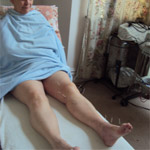Smoking and your spine
Most people know that cigarette smoking is extremely bad for your health. It’s a major cause of cancer, heart disease, stroke, emphysema, dementia and depression – the list goes on. But did you know that nicotine, a major (and the most addictive) constituent of tobacco – whether taken as cigarettes, e-cigarettes and gum – can also damage your spine and bones?
The link between smoking and poor bone health
Tobacco is full of chemicals – there are over 7,000 – and 250 of those are known to be really harmful. As well as nicotine and carbon dioxide, they include ammonia (used in toilet cleaners) arsenic (poison), formaldehyde (dry cleaning fluid) and butane (lighter fluid)!
When you smoke, these nasties enter the bloodstream and are dispersed throughout the body’s tissues, causing damage and inflammation. For the purposes of this article, the harm they do within blood vessels is especially significant. Smoking reduces the peripheral circulation to the muscles leading to greater musculoskeletal pain, especially back pain. Decreased blood flow to the tissues, including the intervertebral disc area, is a major factor in the development of degenerative disc disease, one example being the dreaded bone-thinning disease osteoporosis which can, in turn, lead to curvature of the spine (kyphosis).
Smoking and degenerative disc disease
For those of you who aren’t familiar with discs and the vital role they play, here’s a quick anatomy lesson. Extending from the top of your neck to your pelvis, your spine is comprised of 24 rectangular bones, known as vertebrae, which are separated by soft pads (discs), connected via ligaments (sturdy strips of tissue) and strengthened by spinal muscles. Discs are hugely important because they act as shock absorbers, cushioning each vertebra from the next, providing spinal stability, proper alignment and enabling movement between vertebral bones. Under normal circumstances, they receive a rich supply of blood and nutrients via capillaries to the vertebral bones.
But smokers’ vertebrae and discs are generally poorer, softer and weaker, thanks to a reduced supply of blood, nutrients and minerals. There’s also evidence that the toxicity of nicotine may cause cell damage within discs, gradually impairing their function and causing them to slide into degenerative disc disease.
This is a condition where vertebral discs become softer and, over time, become unable to act as cushions between the vertebrae, resulting in arthritic changes, improper alignment, pinched nerves, herniated discs – all leading to severe back pain. Discs can degenerate as part of the ageing process or thanks to injury, but smoking not only damages healthy discs but speeds up the disintegration of already damaged ones.
Osteoporosis is just one type of disc degenerative disease and occurs when someone loses too much bone and the body simply cannot replace this. The resulting loss of bone mass means that the remaining bones become fragile and susceptible to fractures, especially in the spine. In fact, male smokers have a 32% increased risk of developing a spinal fracture, with a 13% increase in women who smoke.
Smoking and kyphosis
Everyone has some degree of curvature in the middle section of the spine (the thoracic vertebrae) to allow space for organs such as your lungs and heart. But sometimes kyphosis can occur, causing the top of the spine to be more rounded than normal. This condition can lead to stiffness, tenderness and back pain as the body compensates for the spinal abnormality and, in extreme cases, difficulty in breathing. It has several causes – poor posture, an abnormally shaped vertebrae, spinal injury, wear and tear (spondylosis) in the bones, discs and ligaments, osteoporosis and emphysema.
As we’ve already discussed, osteoporosis and wear and tear are caused and made worse by smoking. So is emphysema (now referred to as Chronic Pulmonary Disease or COPD), whereby the lungs’ air sacs become inflamed and damaged, causing breathlessness, coughing, wheezing and a tendency towards infection. Over time, the persistent coughing and wheezing associating with smoking increases the kyphosis, leading to back pain and neck pain due to poor posture… caused by kyphosis. It really is a vicious circle!
Other smoking-related damage
Smoking also:
- Impairs the formation of collagen, an essential structural protein within discs. One study found that exposure to nicotine produces a different type of collagen fibre which stiffens the discs (similar to what occurs during the ageing process) and resulting in accelerated disc disintegration.
- Prevents adequate healing after bone or spinal surgery – smokers are more likely to suffer with post-operative infections and spend longer in hospital.
- Potentially increases sensitivity to pain – one research study among 25,000 patients found that smokers reported more severe spinal symptoms than non smokers.
- Disrupts bone density by reducing the DNA content of osetoblasts (cells that create new bone) causing the death of the cell, contributing to the development of osteopenia (thin/weakened bones) and osteoporosis (brittle bones). Even passive smoking contributes to this.
If you are a smoker and are worried about the effect of smoking on your bone and spinal health, please get in touch. We offer therapies, such as hypnotherapy, at the clinic which may help you to give up smoking.





















